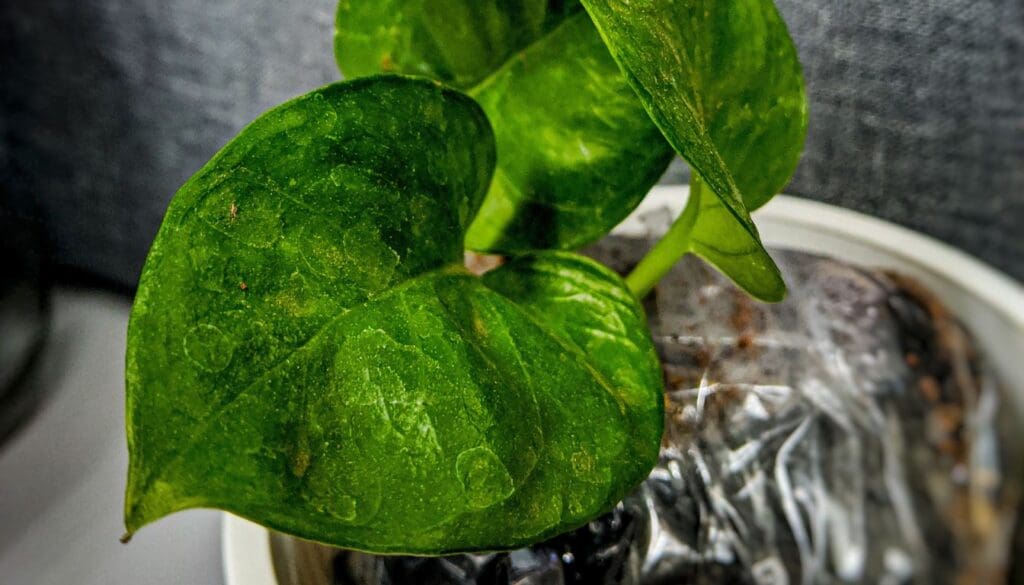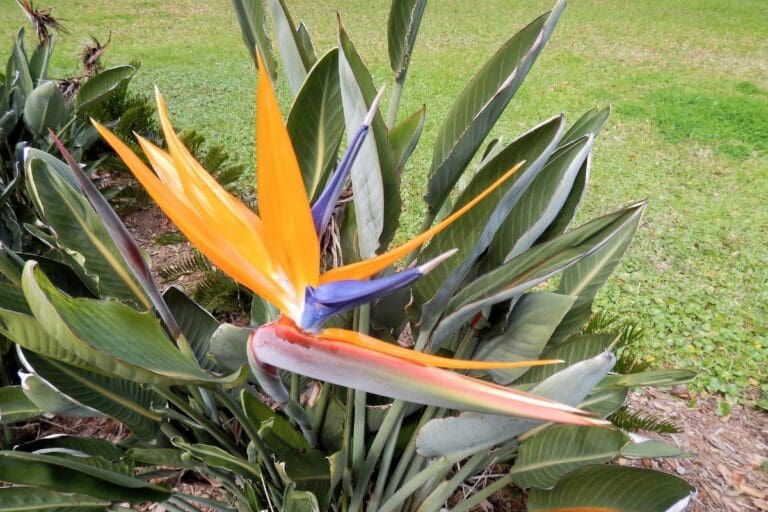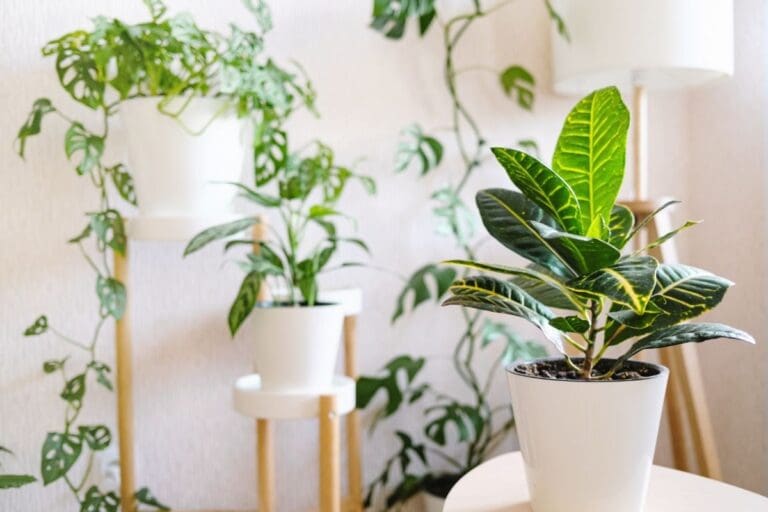Pothos Leaves Curling? 7 Reasons Why & What To Do!
Have you ever woken up to notice the Pothos leaves curling? Curly leaves in Pothos signify that your plant is stressed and something is wrong. Finding out the cause and solving it soon can help prevent further leaf curls.
Pothos leaves curl due to improper watering, direct sunlight, low humidity, fertilizer burns, temperature stress, pests, diseases, or aging. Identify and analyze the problem and fix it promptly to prevent future curling in Pothos.
Fortunately, Pothos is resilient, and several methods exist to correct the problems associated with curling. Keep reading this article to learn what I found about the reasons causing curling in Pothos in my 12 years of gardening experience, how to solve and prevent the problem, and how to reverse the curling.

Please note: Simplify Plants is reader-supported. Some links in the post are affiliate links and I get a commission from purchases made through links in the post.
1. Improper Watering Leading to Curling Leaves in Pothos
Both overwatering and underwatering can cause the Pothos leaves to curl.
When the soil is waterlogged for too long, the roots suffocate, failing to pass the moisture and nutrients to other plant parts.
The leaves curl is a common mechanism in the plant to retain the remaining moisture and survive moisture loss.
On the other hand, underwatering dehydrates the pothos roots and makes it difficult to pass the nutrients and moisture to the other plant parts.
The cells of the pothos leaves become droopy, lose their turgor due to lack of moisture, and they curl to survive and hold the remaining moisture.
To fix the curling leaves in pothos, you must improve your watering habits by learning watering tips and techniques and paying more attention to the soil’s moisture level.
If you have overwatered, stop watering and let the soil dry.
If you have underwatered, start watering immediately. Consider deep watering.
If the soil repels water from the top, consider bottom watering.
Use your finger or a moisture meter to check the soil’s moisture level.
You can only water your Pothos if the top 2-3 inches or 40-50% of the soil has dried.
Check the moisture level 1-2 times per week.
After years of experience, you can make a routine based on your plant’s behavior.
I water my Pothos every 5-7 days in spring and summer and every 7-14 days in winter.
But before watering, I always check the moisture level because the drying time of the soil depends on the weather conditions.
2. Direct Sunlight Causing Pothos Leaves to Curl
Check the light conditions around your Pothos to see if watering is not the issue.
Pothos thrive best under bright, indirect, or dappled sunlight for 10-12 hours.
When exposed to direct sunlight, the leaves curl away from light as a protective mechanism from getting burnt.
Over time, the leaves will dry out and burn if you don’t move Pothos away from that place.
On the other hand, gardeners keep them in dark corners because Pothos can tolerate low light.
While that’s true, dark corners with no light will make the leaves curl towards the light.
Check the light conditions and take action to fix it.
If there is too much direct sun from the window (primarily south and west-facing windows are the culprit), move it 8-9 ft. away.
Put up sheer curtains or Venetian blinds to filter the direct sunlight.
If you have an east-facing window, shift your plant near it.
Since the direction provides gentle sunlight throughout the day, you don’t have to worry about direct sun or putting up any filters.
If the light seems low, shift your Pothos to a location with bright, dappled sunlight or use LED lights.
If your Pothos still curls after you have set LED lights, the light must be close to the plant, and it’s overheating.
LEDs can produce enough heat; maintain 6-12 inches in between.
3. Low Humidity Resulting in Curled Leaves on Pothos

Pothos belong to tropical regions and love around 70-80% humidity.
It not only helps them flourish but also encourages flowering.
But such high levels can be uncomfortable indoors.
Hence, maintain at least 50-60% humidity levels.
With low humidity below 40%, the leaves start curling to retain the remaining moisture.
Over time, the leaves will lose moisture, become dry and crispy, and turn brown.
To understand the humidity, install a hygrometer. If it’s lower than 40%, here are a few options:
- Mist your Pothos once a week.
- Install humidifiers.
- Keep a pebble tray under the Pothos pot. As the water evaporates, it adds moisture to the air.
- Place the Pothos near the aquarium. Or, keep some water trays around the plant. As water evaporates, it adds moisture to the air.
- Group multiple tropical plants, ensuring good airflow and avoiding touching each others’ leaves.
- Put a moss pole near the plant.
- Keep your Pothos in a bathroom near a window providing dappled sunlight. With every hot shower, Pothos will receive good humidity.
Wait for some days and see if there are any curls. If the leaves are in good shape, you have solved the issue.
4. Fertilizer Burns Prompting Curling of Pothos Leaves
Soil alone cannot provide all the nutrients to Pothos plants.
Besides, soil can deplete over time.
Hence, you need to feed your Pothos.
While the plant benefits from feeding, excessive fertilizer usage will not benefit Pothos.
The mineral salts in the fertilizer accumulate in the soil and burn the roots.
The high salt concentration and fertilizer imbalance curl the leaves and distort them.
Over time, these leaves turn brown at the tips and edges, indicating scorches.
If you have provided extra fertilizer 1-2 times, stop feeding the plant and see how it reacts.
If the plant shows signs of recovery, start feeding again with low doses.
If you have been overfertilizing for extended periods, here’s what you should do:
- Stop feeding and flush off the soil with deep watering. Let the soil dry a bit and water it again. Do this 2-3 times unless the accumulated water drains out. Start feeding once you notice recovery signs.
- You can uproot your Pothos, replace the entire soil, and repot it. Use new, well-drained, fertile soil mix. Start fertilizing after you notice new growth.
Fertilize your Pothos every 4-6 weeks in active months using liquid fertilizer and 1-2 times a year with slow-release fertilizer.
Always dilute your fertilizer to half the recommended strength.
For example, mix ¼ to ½ teaspoon of fertilizer for every 2 cups of water.
5. Temperature Stress Causes Curling Leaves in Pothos
Pothos prefer warm temperatures between 65°F and 90°F and perform best in 70-90°F.
High temperatures exceeding 90°F are the leading cause of leaf curl in Pothos.
High temperatures can dry the surrounding air, and leaves lose moisture faster.
Pothos leaves curl upwards, a process known as cupping, and adapt to excessive moisture loss to retain the moisture.
Sometimes, temperatures below 55-60°F can also cause the Pothos leaves to curl at the tips.
Check your room temperature if leaves are curling and the above reasons are not the cause.
Shift your Pothos to a room with consistently warm temperatures.
It should be neither below 65°F nor above 90°F.
Keep your plant away from drafty doors, windows, and open balconies.
Avoid keeping your plant close to heating or cooling systems, radiators, generators, or air vents.
If you have kept the plant in rooms containing these units, maintain a 10-12 ft. distance in between.
6. Pests and Diseases Triggering Curling Leaves on Pothos

Various pests and diseases can cause the Pothos leaves to curl.
Common pests like aphids, spider mites, mealybugs, and whiteflies suck the Pothos sap and dehydrate it.
Over time, the leaves will curl, become dry, and deform.
Common bacterial and fungal diseases like leaf spots, root rot, and blights can cause the leaves to curl, wilt, and turn yellow out of stress.
Before treating the issue, closely examine the Pothos to confirm the problem.
If there are pests, you will see them mainly under the leaves and on the stems.
As for the diseases, the leaves will have dark blotches or spots with discoloration.
In root rot, the plant’s base becomes mushy and smelly.
After confirming the issue, proceed with the treatment.
To get rid of pests in pothos plant:
- Quarantine your Pothos and remove the heavily infected leaves.
- Release natural predators like ladybugs and lacewings.
- Spray neem oil to the infected areas, under the leaves and stems.
- Wipe the leaves and stems with a cotton dipped in rubbing alcohol.
- Make a rubbing alcohol solution. Mix 1 part 70% Isopropyl Alcohol with 9 parts water and spray the solution on the infected areas.
- Use soap sprays to suffocate the bugs.
- Spread diatomaceous earth around your plant and soil.
- If the infestation is large, use pesticides containing pyrethrins, pyrethroids, and imidacloprid.
- Apply systemic insecticides for sap-sucking pests. The product gets absorbed by the plant. As these bugs suck the plant sap, they ingest the insecticide and die.
If your Pothos is affected by root rot disease, here are the steps to take:
- Take your Pothos out and remove maximum soil from the root area to examine the roots. The brown and mushy roots are rotten, while the white and firm roots are healthy.
- Cut off the rotten roots, then apply fungicide to the remaining healthy roots. Or, soak them in a hydrogen peroxide solution (1 part hydrogen peroxide and 4 parts water) for 30 minutes. Collect some healthy cutting for propagation if maximum roots have to be removed.
- Take a new pot and fill it with a new soil mix. Ensure the soil is well-drained and fertile. Plant your Pothos in it.
- Provide dappled sunlight and hold watering for 2-3 days to let the roots recover. After a few days, water it evenly for good hydration. Please protect it from stress like drafts or extreme temperature conditions.
- Don’t fertilize until you see signs of new growth.
To control other fungal and bacterial diseases:
- Isolate your plant and remove the infected leaves.
- Avoid excessive moisture levels for some weeks.
- Avoid overhead watering.
- If the humidity is high, reduce it with dehumidifiers and increase airflow by opening nearby windows and running a fan.
- Use fungicides, especially copper-based fungicides, to kill the spores.
Preventing diseases is the best way out, as some diseases are incurable:
- Avoid overhead watering, and don’t let the humidity go beyond 70-80%. If many tropical plants are close, maintain a reasonable distance and increase airflow. Don’t let the leaves touch each other.
- Avoid misting. Even if you do, ensure the leaves dry out by the end of the day.
- Sometimes, water with a hydrogen peroxide solution kills the fungal spores.
- Add a few drops of neem oil to the water. While watering, add neem cakes to your potting mix.
7. Genetic Factor Contributing to Curling Pothos Leaves
Sometimes, curling in Pothos is a genetic factor or natural.
When new leaves grow on a Pothos plant, they stay curled at the edges. As they mature, they will unfurl on their own.
The leaves curl initially to retain the moisture for sufficient growth.
As the leaves mature, they flatten out.
I never knew this until I noticed.
I was doing everything correctly, but still, I saw curls, and my plant was shiny and healthy.
Observing my plant, I noticed the leaves had unfurled and flattened out.
Another situation where I saw this same behavior is when these leaves get old over time.
The old leaves lose their energy to uptake moisture and nutrients.
They curl to retain as much water as possible.
As they entirely lose their energy, they turn yellow and fall off the plant.
Your Pothos will remain healthy and vigorous in these situations but still have discolored or curling leaves. It is natural, and there is no solution.
Pothos maintenance and care tips to prevent curling

- Provide your Pothos with 10-12 hours of bright, dappled sunlight.
- Water your plant whenever the top few inches are dry. Increase the watering frequency in summer and reduce in winter. Check the moisture level once a week. Make a schedule once you know enough about Pothos’s absorption rate.
- Use well-drained fertile soil for Pothos. Make sure the pot also has drainage holes.
- Fertilize your Pothos every 4-6 weeks with a liquid fertilizer or 1-2 times a year with a slow-release fertilizer. Always feed in the spring and summer and avoid it in winter. Dilute your fertilizer to half the recommended strength to avoid burns.
- Maintain 65-90°F temperatures and 50-60% humidity levels. Protect from hot or cold drafts and extreme temperatures.
- Repot your Pothos every 1-2 years during the active months. Use a container 1-2 inches bigger than the old one. Care for your Pothos post-repotting to reduce transplant shock.
- Prune your Pothos then the leaves overgrow for good airflow.
- Increase air circulation by running a fan, maintaining distance between plants, and opening the nearby windows.
- Check out for pests and diseases and treat them immediately to prevent the issue from spreading. Spray neem oil solution to your Pothos every 2-3 weeks to keep insects and pathogens at bay.
Final thoughts
Pothos is a resilient and low-maintenance plant. However, if their leaves start curling, it indicates something is wrong with their basic care.
Common reasons for Pothos leaves curling are improper watering habits, inadequate light conditions, low humidity, fertilizer burns, temperature stress, and pests and diseases. It is natural if your Pothos is healthy, but the leaves still curl.
Old and new leaves curl to retain moisture. Examine your Pothos, identify the signs, and promptly address the issue to prevent leaf curling. Follow the essential care tips properly to prevent curling of the Pothos leaves in the future.
Will the curly Pothos leaves uncurl?
It depends on the cause of the curling. The unfurling of the new leaves is natural. If you examine and treat the problem initially, the leaves might be able to uncurl. Unfortunately, the damage is irreversible most of the time.
Should I remove the curled leaves from Pothos?
Cut off curled Pothos leaves if they stay curled even after the plant has recovered from the issue. It will improve your plant’s appearance and encourage it to grow new leaves.
Reference: Pothos Wikipedia
Recommended Garden Supplies
| Product Image | Our Recommended Gardening Supplies | Check Offers! |
|---|---|---|
Top Top
Top
Top
Top
Top
Top
Top
Top | rePotme Houseplant and Tropical Classic Potting Soil Mix | Check Offer On Amazon |
 Top
Top
Top
Top
Top
Top
Top
Top | Espoma Organic Indoor Plant Food | Check Offer On Amazon |
 Top
Top
Top
Top
Top
Top
Top
Top | GooingTop LED Grow Light 6000K Full Spectrum Clip Plant Growing Lamp | Check Offer On Amazon |
 Top
Top
Top
Top
Top
Top
Top
Top | Soil Moisture Meter | Check Offer On Amazon |
 Top
Top
Top
Top
Top
Top
Top
Top | Govee Hygrometer Thermometer, Bluetooth Enabled! | Check Offer On Amazon |
 Top
Top | LEVOIT Humidifiers for Large Room(Best For Plants) | Check Offer On Amazon |
 Top
Top
Top
Top
Top
Top
Top
Top | Upgraded DIY Automatic Drip Irrigation Kit, 15 Potted Houseplants Support | Check Offer On Amazon |
 Top
Top
Top
Top
Top
Top
Top
Top | Stainless Steel Heavy Duty Gardening Tool Set | Check Offer On Amazon |
 Top
Top
Top
Top
Top
Top
Top
Top | Bonide Insecticidal Soap | Check Offer On Amazon |
 Top
Top
Top
Top
Top
Top
Top
Top | Bonide 32 oz Spray Neem Oil for Organic Gardening | Check Offer On Amazon |
 Top
Top
Top
Top
Top
Top
Top
Top | Garden Safe Fungicide | Check Offer On Amazon |






